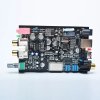Willen
Well-Known Member
I saw some of very high quality audio recording devices like mic preamp or audio interfaces. All of them have electrolytic capacitors. No film capacitors (known as the best for audio). They used SMD electrolytic there. What is fact? Do I get even more quality than 'professional' level if I changed them with film? But they are more than few uF rated and it's hard to get high value film.



